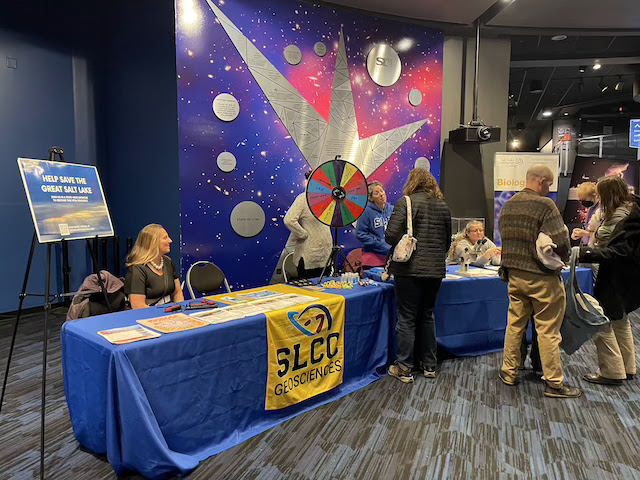In partnership with Salt Lake Community College, Clark Planetarium is hosting a series of lectures that explore subjects within the field of environmental science. The planetarium will hold these events in the Northrop Grumman IMAX Theatre on the second Thursday of every month, leading up to Earth Day in April.
“We at Clark Planetarium really wanted to bring an opportunity to learn science from local scientists and so we decided that we would start with a lecture series about a planet that's very important to us. That is planet Earth,” said Jason Sills, associate division director at Clark Planetarium. The planetarium will host a professor from SLCC each month who will be talking about different aspects of environmental science.
The first of four lectures was held on Jan. 11, where Dr. Maura Hahnenberger spoke on the critical need to conserve the Great Salt Lake. Maura, an atmospheric scientist and professor who teaches Meteorology and Earth Sciences at SLCC, discussed the lake's decline due to human activities.
“What are we doing that is taking water away, that's consuming the water? Agriculture is number one,” Maura said in her lecture. “Agriculture is the biggest user of water. Our analysis showed that 63% of the water that has been consumed, that did not make it to Great Salt Lake, is from agriculture, and that accounts for about seven feet of loss in elevation of the Great Salt Lake.”
She explained how Great Salt Lake supports a unique ecosystem and is an important stopover for millions of migratory birds each year. But the lake is now at a "tipping point" she says, as water levels have dropped significantly since the 1980s. Impacts are already being seen, such as the loss of brine shrimp populations that are a key food source for birds.
“The Great Salt Lake is a habitat for either resident or migratory birds by the millions. And this is an internationally important ecosystem for birds. We have birds that fly all the way from Canada through the Great Salt Lake. They get their food here, and they travel all the way down into South America, Argentina, Chile, so it’s not just our local area being impacted, but this whole Pacific flyway from Canada to South America,” Maura said during her lecture.
Maura also shed light on her research studying dust storms in Utah. With more shoreline exposed as the lake recedes, Great Salt Lake is becoming a larger source of dust, which can pose health concerns and even affect snowpack levels. Dust deposition on snowpack leads to faster melting and less overall runoff into the lake.
“We have this feedback loop of more dust means faster snowmelt, faster snowmelt means less runoff, which means a lower Great Salt Lake and potentially more dust and so that loops around and around,” said Maura.
The talk highlighted ongoing conservation efforts but also noted the challenges posed by increased temperatures from climate change. Maura urged citizens to get involved by supporting advocacy groups, tracking legislation, and taking personal actions like water conservation at home. She provided several tangible steps the community can take to help "save Great Salt Lake."
Join SLCC and the Clark Planetarium this Thursday, Feb. 8 for the second in the series presented by Professor Chris Johnson and five of his students, Windy Martin, Jaydon Andersen, Erika Downs, Bryan Christensen, and Braxton Powell, from the Geoscience department.
Speakers will summarize historical mining activities in the Central Wasatch and discuss how heavy metals can impact stream water and soil from old mine drain tunnels and mine dumps. Hear about the undergraduate research that is being done in the Geoscience department including the use of analytical tools to measure the impact of heavy metals in water and soil, microfossils from Millcreek Canyon, and mapping of new landslide hazards in Summit County using LiDAR.
This event is free, but seating is limited. For more information and to reserve your seat visit this website.
When: Thurs., Feb. 8 at 7 p.m.
Thurs., March 14 at 7 p.m.
Thurs., April 11 at 7 p.m.
Where: Clark Planetarium, 110 S. 400 W.
Cost: Free




Comments
Post a Comment